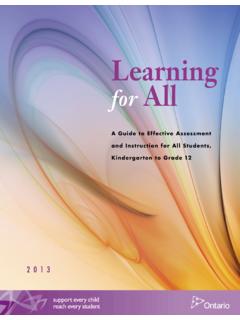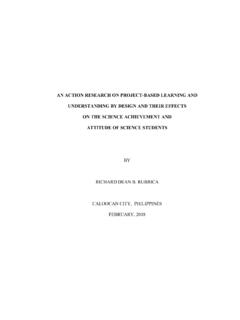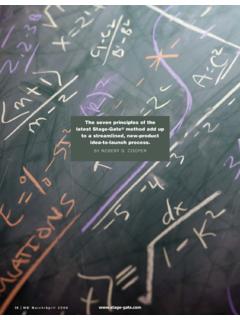Transcription of English Learning Strategies among EFL Learners: A ...
1 English Learning Strategies among EFL Learners: A Narrative Approach Hoang Nguyen University of Tasmania, Australia Daniel R. Terry University of Melbourne, Australia Abstract Language Learning Strategies (LLSs) are believed to be influenced by individual differences as well as environmental and contextual factors. Therefore, the effective use of LLSs is determined by various factors, including both Learning and learner variables. This dynamic and complex nature of LLSs renders it appropriate to use a qualitative approach to undertake research into this issue. This paper details the qualitative findings from a larger-scale study on English LLSs among tertiary students in the context of Vietnam.
2 The data was gathered from semi-structured interviews with 10 English as a foreign language (EFL) teaching staff and 10 EFL students at a university in Vietnam. Interviews were conducted in Vietnamese lasting 30 to 40 minutes, and were audio recorded with consent. The interview questions for students focussed on their general attitudes and lived experiences of LLSs. Similarly, the interview questions for EFL staff were structured around their general attitudes. The interview data were translated into English , rechecked, and thematically analysed. The findings are of a textual and interpretative nature with emerging themes and issues related to the attitudes towards and actual use of LLSs among the target learners.
3 The findings provide practical implications for practitioners, researchers and educational policy makers alike. Keywords: language Learning Strategies , Vietnamese, English , second language Learning , tertiary students IAFOR Journal of Language LearningVolume 3 Issue 1 Spring 201741 Introduction Successful Language Learning Strategies In the field of second/foreign language teaching and Learning , the interests of practitioners and researchers have been geared to the language Learning Strategies (LLSs) selection and adoption of successful language learners. The suggestion that a good language learner may have some special Strategies that others could learn from was initially introduced by Rubin (1975).
4 Using a mixed methods approach including classroom observation, self-observation, and interviews, Rubin proposed a list of seven characteristics of good language learners. They include the ability to make good guesses, communicate in many ways, tolerate mistakes, pay attention to form and communication, practise the language regularly, monitor one s own language use, and understand and attend to meaning. With the same goal, to help less successful learners enhance their success, Stern (1975) introduced his description of good language learners with ten LLSs, which were drawn from his interpretation of language competence and second language acquisition; his experience as a teacher and learner; and his review of the literature of language Learning .
5 The most significant elements in his proposed Strategies were the initiative and activeness of the learners in approaching a Learning task or problem. Findings by Rubin (1975) and Stern (1975) have been supported and further developed by many subsequent researchers in the field (Green & Oxford, 1995; Naiman, Froehlich, Stern, & Todesco, 1978; Rubin & Thompson, 1982). These early research studies have set the scene for an emerging interest in how language learners themselves go about Learning and what teachers can do to assist learners during that process. However, Rubin (1975) recognized the influence that many variables, such as target language proficiency, age, situation, cultural differences and Learning styles, may have on the deployment of LLSs.
6 As such, Naiman et al. (1978, p. 224) stressed that there were no predetermined overall characteristics among good language learners due to the various individual pathways that could lead to successful language Learning . This emphasis on individual variation in LLS use has become a principle for most research efforts in the field. On the one hand, it highlights the issue of individual differences and underscores the flexibility in language Learning strategy deployment. On the other hand, it puts a restriction on the generalizations to any target population beyond the sample of any research findings about the good language learners.
7 Learning Environment and LLSs According to socio-cultural theory, social interaction and cultural institutions play an important role in an individual's cognitive growth and development (Donato & MacCormick, 1994). From this socio-cultural perspective, the Learning environment and contexts are influential upon individuals strategic orientations to language Learning . Scarcella and Oxford (1992), Lantoff and Appel (1994) and Donato and MacCormick (1994) discovered that social interaction had a crucial role to play in LLS use. Likewise, Gao (2006) pointed to the dynamicity of LLS selection and use under the influence of different Learning contexts.
8 His comparative qualitative study suggested that the popular language Learning discourses and assessment methods had influenced the learners frequency and choices of strategy use. More recently, Huang and Andrews (2010) examined the impact of the Learning context and environment on LLS use among 47 senior secondary students in mainland China. Their findings revealed that in the mainstream exam-orientated environment of Mainland China, the general orientation of Strategies for a variety of classroom Learning tasks was determined by IAFOR Journal of Language LearningVolume 3 Issue 1 Spring 20175the grade-getting goal.
9 In addition, the results indicated that the processes of strategy development and use were mediated by learners' situated Learning experience; by cultural artefacts (tasks); and by interpersonal interactions with their teachers, peers and family members. From a holistic view, the learners strategy employment was situated in their communities of language Learning practices and social cultures. The use of LLS reflects individual differences and they have a propensity to be continuously shaped and reshaped by the environmental and contextual factors. The dynamicity and complexity of LLSs are under the influence of different Learning contexts and environments, which render it appropriate to use a qualitative approach to undertake investigations.
10 This is particularly vital when examining the LLSs among tertiary students in Vietnam, where research into LLS remains in the early stages of development (Duong & Nguyen, 2006). The overall study aimed to examine the frequency and patterns of LLS use among Vietnamese EFL tertiary students; the relationship between LLS use and self-rated English proficiency; and the specific aim here was to investigate and evaluate the use of LLS among Vietnamese EFL students and staff in the context of Vietnam. 2 Methods This study utilized the conceptual framework of socio-cultural theory, in that Learning is a social process where the development of cognition occurs through the interaction with others in a society and also influenced by the culture where an individual is situated (Donato & MacCormick, 1994; Lantolf, 2000; Lantolf, Thorne, & Poehner, 2015).



















